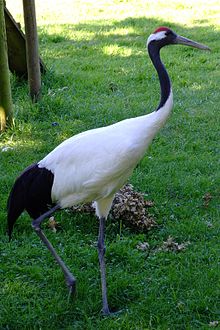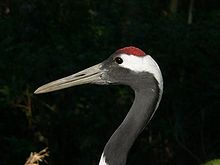- Red-crowned Crane
-
Red-crowned Crane 
At Marwell Wildlife, England Conservation status Scientific classification Kingdom: Animalia Phylum: Chordata Class: Aves Order: Gruiformes Family: Gruidae Genus: Grus Species: G. japonensis Binomial name Grus japonensis
(Statius Müller, 1776)[1]The Red-crowned Crane (Grus japonensis), also called the Japanese Crane or Manchurian Crane (Chinese: 丹顶鹤 or 丹頂鶴; Hanyu Pinyin: Dāndǐng Hè; Japanese: 丹頂 or タンチョウ, tancho; the Chinese character '丹' means 'red', '頂/顶' means 'crown' and '鶴/鹤' means 'crane'), is a large east Asian crane and among the rarest cranes in the world. In some parts of its range, it is known as a symbol of luck, longevity and fidelity.
Description
Adult Red-crowned Cranes are snow white with black to the wings (appears almost like a black tail when standing, but the real tail feathers are white), blackish to the head and neck, and a patch of red skin on the crown. This patch of skin becomes brighter red when the crane becomes angry or excited. This species is among the largest cranes, typically measuring about 158 cm (62 in) tall, 136 cm (54 in) in length (from bill to tail tip) and spanning 242.5 cm (95.5 in) across the wings.[2][3][4] Typical body weight can range from 7 to 10 kg (15 to 22 lb), with males being slightly larger than females and weight ranging higher just prior to migration.[5][6] On average, it is the heaviest crane species, although both the Sarus and Wattled Crane can grow taller and exceed this species in linear measurements.[6][7][8][9] The maximum known weight of the Red-crowned Crane is 15 kg (33 lb).[10][11]
Behaviour
In the spring and summer, the migratory populations of the Red-crowned Crane breed in Siberia (eastern Russia), northeastern China and occasionally in northeastern Mongolia[1] (i.e., Mongol Daguur Strictly Protected Area). Normally the crane lays 2 eggs, with only one surviving. Later, in the fall, they migrate in flocks to Korea and east-central China to spend the winter.[1] Vagrants have also been recorded in Taiwan.[1] In addition to the migratory populations, a resident population is found in eastern Hokkaidō in Japan.[1] The habitats used are marshes, riverbanks, rice fields, and other wet areas.
The crane eats small amphibians, aquatic invertebrates, insects, and plants that grow in marshes and swamps.
Status
The estimated total population of the species is only 2,750 in the wild, including about 1,000 birds in the resident Japanese population.[1] Of the migratory populations, about 1,000 winter in China (mainly at the Yellow River delta and Yancheng Coastal Wetlands), and the remaining winter in Korea.[1]
The National Aviary in Pittsburgh, Pennsylvania ran a program where U.S. zoos donated eggs which were flown to Russia and raised in the Khinganski Nature Reserve and released into the wild. This program sent 150 eggs between 1995-2005. The program has been put on hold in order to concentrate on different crane conservation programs in Russia, such as education and fire suppression (Red-crowned Crane SSP). Several hundred Red-crowned Cranes are kept in zoos around the world.[12]
Culture
 One of the official logos of Japan Airlines featured a Red-crowned Crane.
One of the official logos of Japan Airlines featured a Red-crowned Crane. (video) A Red-crowned Crane feeding.
(video) A Red-crowned Crane feeding.
In Japan, this crane is known as the tancho and is said to live for 1,000 years. A pair of Red-crowned Cranes were used in the design for the Series D 1000 yen note (reverse side). In the Ainu language, the Red-crowned Crane is known as sarurun kamuy or marsh kamuy. At Tsurui they are one of the 100 Soundscapes of Japan.
In China, the Red-crowned Crane is often featured in myths and legends. In Taoism, the Red-crowned Crane is a symbol of longevity and immortality. In art and literature, immortals are often depicted riding on cranes. A mortal who attains immortality is similarly carried off by a crane. Reflecting this association, Red-crowned Cranes are called xian he (仙鹤), or fairy cranes. The Red-crowned Crane is also a symbol of nobility. Depictions of the crane have been found in Shang Dynasty tombs and Zhou Dynasty ceremonial bronzeware. A common theme in later Chinese art is the reclusive scholar who cultivates bamboo and keeps cranes.
Because of its importance in Chinese culture, the Red-crowned Crane was selected by the National Forestry Bureau of the People's Republic of China as its only candidate for the national animal of China. This decision was deferred because the Red-crowned Crane's Latin name translates as "Japanese Crane".[13]
See also
- Wildlife of China, for more endangered species
- List of Special Places of Scenic Beauty, Special Historic Sites and Special Natural Monuments
References
- ^ a b c d e f g h "Grus japonensis". IUCN Red List of Threatened Species. Version 2010.4. International Union for Conservation of Nature. 2009. http://www.iucnredlist.org/apps/redlist/details/143784. Retrieved 19 April 2011.
- ^ japonensis (2011).
- ^ [1] (2011).
- ^ Crane- Oiseaux card (2011).
- ^ [BirdLife International (2000), Threatened Birds of the World, Lynx Edicions and BirdLife International, Barcelona and Cambridge] Red-crowned Crane - ICF
- ^ a b CRC Handbook of Avian Body Masses by John B. Dunning Jr. (Editor). CRC Press (1992), ISBN 978-0849342585.
- ^ Wattled Crane profile (2011).
- ^ Sarus Crane profile (2011).
- ^ Crane (2011).
- ^ Welcome to Cyber Crane
- ^ The Wildlife Year, The Reader's Digest Association, Inc. (1991). ISBN 0-276-42012-8.
- ^ ISIS (2011). Grus japonensis. Version 28 March 2011
- ^ Controversy over the Red Crowned Crane's Candidacy for National Bird Status (丹顶鹤作为候选国鸟上报国务院 因争议未获批)
- Craft, Lucille. 1999. "Divided by Politics, United in Flight - Can Japan and Russia Resolve Their Differences Over the Remote Kuril Islands and Protect the Rare Red Crowned Crane?" International Wildlife. 29, no. 3: 22.
External links
- BirdLife Species Factsheet.
- International Crane Foundation Red-crowned Crane page
- Three White Cranes, Two Flyways, One World An educational website that links schools along the eastern Whooping Crane flyway in the USA with schools along the eastern flyways of the Siberian and Red-crowned Cranes in Russia and China.
- Japanese Crane (Grus japonensis) from Cranes of the World (1983) by Paul Johnsgard
Cranes (order: Gruiformes • family: Gruidae) Subfamily Balearicinae
(crowned cranes)Black Crowned Crane (B. pavonina) • Grey Crowned Crane (B. regulorum)Gruinae
(typical cranes)Common Crane or Eurasian Crane (G. grus) • Sandhill Crane (G. canadensis) • Whooping Crane (G. americana) • Sarus Crane (G. antigone) • Brolga (G. rubicunda) • Siberian Crane (G. leucogeranus) • White-naped Crane (G. vipio) • Hooded Crane (G. monacha) • Black-necked Crane (G. nigricollis) • Red-crowned Crane (G. japonensis)Blue Crane (A. paradisea) • Demoiselle Crane (A. virgo)BugeranusWattled Crane (B. carunculatus)15 living species in four generaCategories:- IUCN Red List endangered species
- Grus
- Birds of China
- Birds of Japan
- Special Natural monuments of Japan
Wikimedia Foundation. 2010.


